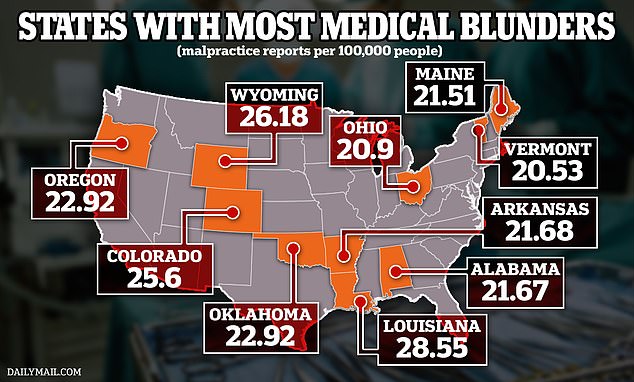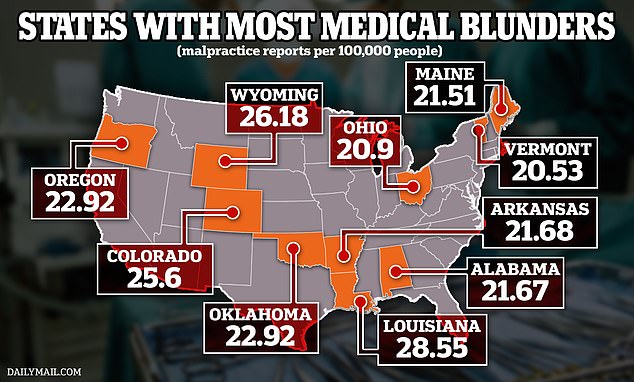


A urologist removes a kidney from the wrong patient. A nurse incorrectly administers a paralyzing drug, resulting in the patient’s death. A neurosurgeon operates on the wrong side of a woman’s brain.
Medical errors like these harm 1.2 million Americans and result in the deaths of an estimated 251,000 patients each year.
Both publicly and informally, doctors with specialties ranging from family medicine to emergency medicine told DailyMail.com about the dangerous medical accidents that occur within the walls of hospitals that health care providers are tempted or encouraged to cover up.
The most common causes are: prescribing the wrong medication and giving medication to the wrong patient. It is estimated that 8,000 patients die each year.
Errors in obtaining the correct laboratory tests, as well as errors in recordkeeping and administrative work, such as mislabeling results or diagnoses, are common errors in hospitals and private practices, perhaps more so than patients realize.

The map above shows the states with the most medical malpractice lawsuits
Dr. Andrea Austin, an emergency physician in Southern California, told DailyMail.com: ‘Some of the mistakes I’ve seen happen [are] wrong medications are ordered – and while the person ordering the medication is ultimately responsible, these mistakes don’t just happen. It’s a larger system problem.
‘Sometimes the wrong test gets ordered… And depending on where we’re working, sometimes the amount of distractions and interruptions… It’s a very common occurrence in the emergency department [to] being interrupted eight to ten times an hour when you want to order high-risk medications and tests.
‘There is a risk that the wrong test is requested for the wrong patient or that the wrong medication is prescribed.’
A devastating medical error captured the nation’s attention in 2022. Former Vanderbilt Medical Center nurse RaDonda Vaught was convicted of neglect and manslaughter and given a three-year suspended sentence.
In December 2017, Mrs. Vaught was scheduled to give her patient Charlene Murphey a dose of Versed, a sedative to calm her down before she went into a large MRI-like machine. Instead, the 75-year-old woman was injected with vecuronium, an extremely powerful paralyzing agent.
By the time the error was discovered, Mrs. Murphey was already dead.
When Vanderbilt reported the death to the coronerthe error was not mentioned and the cause of death was ruled ‘natural’.
Mrs. Vaught acknowledged her mistake, but at the same time she called attention to the many other factors that played a role in her fatal error. For example, she was also training a new nurse, which was a distraction. The new electronic records system had only been implemented seven weeks earlier, which was a difficult rollout. In addition, there were timing rules for administering the medications, which forced her to work in a hurry.
The case became a rallying cry for nurses, who insisted that Prosecuting Vaught would have a chilling effect on health carewhich discourages doctors from admitting mistakes for fear of losing their jobs or facing jail time.
Linda Aiken, a professor of nursing and sociology at the University of Pennsylvania, said of the case: “Everyone agrees that it will have a dampening effect on the reporting of errors or near misses, which in turn will have a negative effect on safety.
“The only way to really learn about errors in these complicated systems is for people to say, ‘Oh, I almost gave the wrong drug because…’ Well, no one’s going to say that anymore.”
Dr. Drew Remignanti, a retired emergency room physician from New Hampshire, told DailyMail.com about the time he misdiagnosed a spot on a patient’s cornea, describing it as a scratch on his nail caused by putting in his contact lenses.
Scratches on the cornea are usually treated with antibiotic drops and heal relatively quickly.
But Dr. Remignanti had misdiagnosed the patient; there was an ulcer on his cornea.
A year later, Dr. Remignanti was told that he was being sued for medical negligence, as he had not contracted the infection himself at the time. As a result, the patient later had to undergo surgery with another doctor, where part of his cornea was replaced with tissue from a donor.
Dr. Remignanti, who wrote about the confusion in his book The healing connectionsaid: ‘This is an example of what we call confirmation bias, where you see what you expect to see… Even though the defect was round and regular, I didn’t want to think beyond the very first conclusion that was drawn.
“I should have known better and been more thorough in my evaluation and decision-making.”
In case of another medical error, Dr. Ashish Jha, an internist at Harvard, once prescribed medication to the wrong patientwhom he mistook for someone else.
He said, ‘They were two of my patients with very similar names and I just prescribed it to the wrong patient.
‘I felt terrible, I felt incompetent, I felt a little ashamed. My first instinct was not to fix the problem, but to not tell anyone.
“It is clearly not the right approach, but we must first acknowledge that this is a very human reaction.”

Medical errors harm 1.2 million Americans and result in the deaths of an estimated 251,000 patients each year (stock photo)
Doctors say they often learn to hide mistakes because admitting to them could lead to lawsuits from patients or their families.
But Dr. Austin said this shows how broken the system is. Without admitting mistakes, the doctor who made them is unlikely to improve and more can happen.
And because most medical errors often go unreported, the exact extent of the problem is unknown.
Dr. Danielle Ofri, an internist at Bellevue Hospital in New York City, told NPR: ‘I don’t think we’ll ever know what the death toll is in terms of [due to] medical error — but it is not a small one.’
She added: ‘Near misses are the huge iceberg beneath the surface where all future failures happen. But we don’t know where they are, so we don’t know where to direct our resources to fix them or reduce the chance of them happening.’
The most comprehensive study of adverse events is the Harvard Medical Practice Study, a 1984 study of more than 30,000 randomly selected discharged patients from 51 randomly selected hospitals in New York State.
The percentage of adverse events attributable to error was 58 percent, and the percentage of adverse events attributable to negligence was 28 percent.
Although most patients who experienced these errors were disabled for less than six months, 14 percent died and three percent suffered permanent disability.
Drug complications, such as allergic reactions and administration errors, were the most common side effect (19 percent), followed by wound infections (14 percent) and technical complications during surgery (13 percent), such as injuries during surgery or bleeding during or after surgery.
Injuries such as excessive bleeding during or after surgery, infection and bone fractures took place in 3.7 percent of hospital admissions.
There is not much other research published on this topic, but one A smaller 2023 study of 2,810 patients from Boston-area hospitals found about 24 percent have experienced at least one adverse event, such as allergic reactions to medications or falls that endangered their health.

Dr. Andrea Austin, an emergency physician based in Southern California, told DailyMail.com that mistakes can be prevented if healthcare workers have the right support systems
It is also common for physicians to misdiagnose patients, especially in stressful emergency departments.
A study published last year in the journal BMJ Quality and Safety Protocol found that 795,000 patients die or become permanently disabled each year as a result of misdiagnosis.
In addition to making misdiagnoses, doctors may also prescribe the wrong tests or incorrectly document their findings, confusing patients and losing or misinterpreting test results.
In the meantime, medication errors can occur at any stage of the care process – ordering, dispensing, administering and monitoring.
Although most medication errors do not result in patient harm, those that do occur more frequently in the prescribing (56 percent) and administration (34 percent) phases of the hospital, and are more likely to be caught during the prescribing phase.
Doctors often cite electronic health records (EHRs), documentation that tracks a patient’s complete medical history, including vaccinations, surgeries and diagnoses, as a source of medical errors.
EHRs are often recorded using outdated technology, Dr. Austin said. The most widely used systems were created in the 1980s, and many hospitals are still running programs from that era.
Physicians and nurses have long believed that completing EHRs takes too long and that the workflow is cluttered and confusing, wasting valuable time on patient care.
Additionally, outdated EHR systems do not have built-in controls to monitor or alert on coding errors, which can mean the wrong diagnosis or the wrong medication.
This is a broader systemic problem that hospitals have not allocated the time and resources to solve.
Dr Austin told DailyMail.com: ‘There should be no reason today why systems should not check if a patient has an allergy or alert a healthcare provider about a patient’s age and pregnancy status.’
She added: ‘To err is human. So when there are humans involved, there is the field of human factors that essentially explains why a lot of these hair mistakes happen. So they are very predictable.
‘If we have a well-functioning system and we support doctors with a well-functioning electronic medical record, and then also the right checks and balances, then many of these errors can be prevented.’


